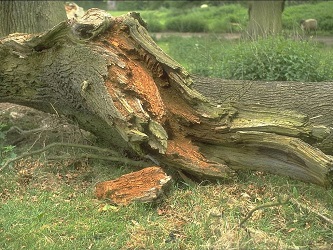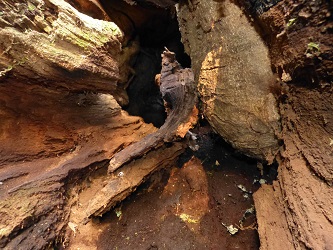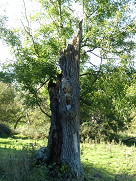Current ISIS code: A211
Previous assemblage name: A211 & A221 heartwood decay in living trees and conifers respectively.
Linked assemblage: Often in association with the other saproxylic assemblages A213 fungal fruiting bodies, and A221 bark & sapwood decay.
Description of habitat typically supporting the assemblage: This assemblage type is mainly characterised by beetles and two-winged flies.
The assemblage type is found in and around mature and ancient trees and shrubs. Many of the two-winged flies are associated with smaller pockets of wet heartwood decay within, for example, cavities resulting from ripped out branches, and a proportion have aquatic or semi-aquatic larvae within waterlogged decayed woody tissues (rot-hole species). In contrast, the rarer and more threatened beetles tend to develop in the main column of decaying heartwood within the trunk, where drainage is free but the atmosphere humid.

Some species developing in debris within tree cavities are also encountered amongst debris accumulations under loose bark.

Heartwood species are dependent on the state of decay rather than the tree species and so non-native tree species can be as important as native ones. Sites with the fullest expression of the assemblage are however historic sites with concentrations of mature and ancient trees, and so ancient wood pasture situations are the most important. This assemblage is Britain’s key ‘old growth’ assemblage.

Open-grown conditions are important for a variety of reasons. Space is needed to enable sunlight to reach the trunk and main boughs, to help raise the temperatures for larval development within and adult flight activity. Trees past full canopy development are vulnerable to canopy competition from younger growth and cannot survive under close-grown conditions. The juxtaposition of mature and aging trees with open areas containing flowering shrubs is a key factor since the adult stages of many of the insect species have a requirement for pollen and nectar. Large herbivores are essential to maintain suitable open conditions.
Potentially important environmental impacts
- Overgrazing leading to reduced regeneration and removal of nectar-providing plants, etc.
- Loss of grazing leading to the smothering of older trees by secondary growth.
- Removal of old trees for health and safety reasons or “tidiness”.
- Intensification of land-use leading to root damage etc.
- Cutting up of dead limbs and fallen trunks leading to changes in microclimate of heartwood decay environment.
Sampling & assessing the assemblage
Standard sampling protocols apply, though sweeping time should be increased.
Target groups: Coleoptera, Diptera.
Fieldwork methods: Beating & targeted search, through inspection.
Alternative methods: Sweep netting if considering the diptera on hawthorn flowers. Vane traps do record part of this fauna if well positioned
Season: Late Spring - the “Hawthorn flowering window”, High Summer & Autumn.
A combination of active visits and passive trapping (vane/interception traps) seems to give the best account of the fauna of these sites. Whilst the RIEC is a cumulative SQI score over a defined period, one can gain some insight from scores derived from summed site samples over a season, treating them as the foundation of a fuller RIEC score. NERR005 has much observation on this assemblage.
